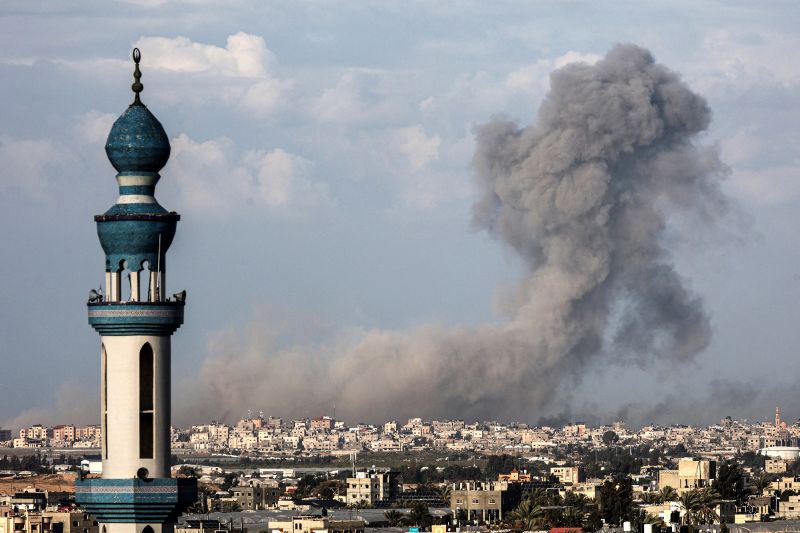
Unimaginable devastation seen inside Khan Younis, the southern Gaza city once a safe haven for the displaced
Scattered around a huge crater are the remnants of a life that is gone. Random pieces of clothing and a red makeup bag lie in the mud. Nearby, an English language textbook, bits of broken furniture and a pillow with floral embroidery are jumbled together in one large pile.
The crater sits right in the middle of a residential neighborhood in central Khan Younis, the besieged city in southern Gaza that is the current epicenter of the war between Israel and Hamas.
The city is the hometown of Hamas’ leader in Gaza, Yahya Sinwar, and, according to the Israel Defense Forces (IDF), a major Hamas stronghold. It’s also an area to which the Israeli military urged large numbers of civilians to flee in the early days of the war, when northern Gaza was the focus of Israel’s operations.
Looking around, it’s clear that the IDF went into Khan Younis with full force.
According to the IDF, the crater is all that is left of a building similar to the others in the area. The military said it was flattened because it sat on top of an entrance to a vast underground tunnel complex.
The IDF says the complex has been used by Sinwar and other Hamas officials to hide since the war began and some of the hostages kidnapped from Israel by Hamas on October 7 were held there. It’s not clear for how long.
Being accompanied by the IDF meant the journalists were only able to see what it allowed them to see.
Driving from the border fence to the heart of Khan Younis in a military vehicle offered a limited vantage point, but there didn’t seem to be a single building that was untouched by the war.
Many buildings have been completely destroyed and the rubble bulldozed away. The ones that are left standing appear damaged beyond any chance of repair. Some look like the ruins of medieval castles – lone walls with holes where windows used to be.
The scale of the bulldozing is apparent when driving through. In some areas, the roads are lined with banks of rubble that are so high that the military vehicle is completely boxed in, driving below the “street level.”
Heavy price
Early in the war, the Israeli military designated Khan Younis as a safer zone and told residents from northern Gaza to seek shelter there. But as the IDF pushed to the south, the city became its next focus. The IDF says Khan Younis is a Hamas stronghold, adding that the tunnel network underneath civilian buildings in the city was likely where Hamas planned the October 7 attacks from.
Many had nowhere else to go and remained sheltering in medical centers and UN facilities in Khan Younis, including the Nasser Medical Complex, Al Amal Hospital and the Palestine Red Crescent Society headquarters. The UN said thousands are still there, and those facilities have also come under attack, according to Hamas-run Palestinian health officials.
The IDF has repeatedly asserted that it seeks to minimize harm to civilians but has come under pressure from the United States and others to do more.
Standing inside the massive crater in Khan Younis on Sunday, Goldfuss admitted the destruction was significant. But he blamed it on Hamas.
Goldfuss said the tunnel network was used by the Hamas leadership to plan the attacks in which Hamas and Islamic Jihad killed more than 1,200 people and abducted more than 250 others to Gaza. Some of the hostages are still likely being held inside the tunnels, he said.
“I’ve (been) asked many questions about the price that Gaza, Khan Younis pays, the houses… yes, definitely, there is a price that has been paid,” Goldfuss said.
“But look around. We are in an ordinary neighborhood and there is a shaft in every place you can find. There’s a shaft in the kindergarten, there’s a shaft in the school, there’s a shaft in the mosques, there’s a shaft in the supermarket, everywhere you go,” he said.
Even this limited glimpse of Gaza makes it clear that four months of Israeli military operations have completely transformed the enclave.
Seen from above, Gaza used to be green and gray: large swaths of fields alternating with densely populated cities. Now, satellite images show a land that’s mostly brown – bombed out and bulldozed over.
